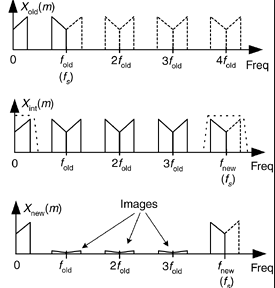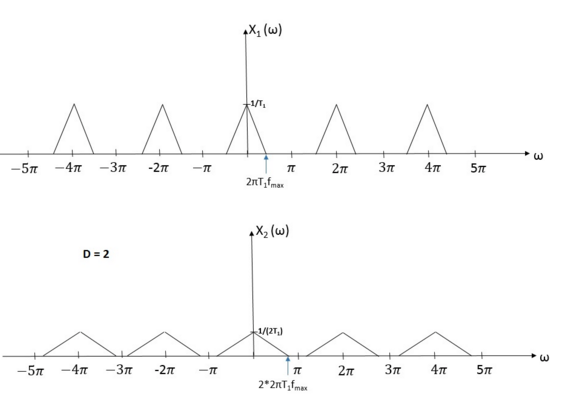This set of Digital Signal Processing Multiple Choice Questions & Answers (MCQs) focuses on “Interpolation by a Factor I”.
1. Which of the following operation has to be performed to increase the sampling rate by an integer factor I?
a) Interpolating I+1 new samples
b) Interpolating I-1 new samples
c) Extrapolating I+1 new samples
d) Extrapolating I-1 new samples
View Answer
Explanation: An increase in the sampling rate by an integer factor of I can be accomplished by interpolating I-1 new samples between successive values of the signal.
2. In one of the interpolation process, we can preserve the spectral shape of the signal sequence x(n).
a) True
b) False
View Answer
Explanation: The interpolation process can be accomplished in a variety of ways. Among them there is a process that preserves the spectral shape of the signal sequence x(n).
3. If v(m) denote a sequence with a rate Fy=I.Fx which is obtained from x(n), then which of the following is the correct definition for v(m)?
a)
x(mI), m=0,±I,±2I.... 0, otherwise
b)
x(mI), m=0,±I,±2I.... x(m/I), otherwise
c)
x(m/I), m=0,±I,±2I.... 0, otherwise
d) None of the mentioned
View Answer
Explanation: If v(m) denote a sequence with a rate Fy=I.Fx which is obtained from x(n) by adding I-1 zeros between successive values of x(n). Thus
v(m)= x(m/I), m=0,±I,±2I….
0, otherwise.
4. If X(z) is the z-transform of x(n), then what is the z-transform of interpolated signal v(m)?
a) X(zI)
b) X(z+I)
c) X(z/I)
d) X(zI)
View Answer
Explanation: By taking the z-transform of the signal v(m), we get
V(z)=\(\sum_{m=-∞}^∞ v(m)z^{-m}\)
=\(\sum_{m=-∞}^∞ x(m)z^{-mI}\)
= X(z-I)
5. If x(m) and v(m) are the original and interpolated signals and ωy denotes the frequency variable relative to the new sampling rate, then V(ωy)= X(ωyI).
a) True
b) False
View Answer
Explanation: The spectrum of v(m) is obtained by evaluating V(z) = X(zI) on the unit circle. Thus V(ωy)= X(ωyI), where ωy denotes the frequency variable relative to the new sampling rate.
6. What is the relationship between ωx and ωy?
a) ωy= ωx.I
b) ωy= ωx/I
c) ωy= ωx+I
d) None of the mentioned
View Answer
Explanation: We know that the relationship between sampling rates is Fy=IFx and hence the frequency variables ωx and ωy are related according to the formula
ωy= ωx/I.
7. The following sampling rate conversion technique is interpolation by a factor I.

a) True
b) False
View Answer
Explanation: From the diagram, the values are interpolated between two successive values of x(n), thus it is called as sampling rate conversion using interpolation by a factor I.
8. The following sampling rate conversion technique is interpolation by a factor I.

a) True
b) False
View Answer
Explanation: The sampling rate conversion technique given in the diagram is decimation by a factor D.
9. Which of the following is true about the interpolated signal whose spectrum is V(ωy)?
a) (I-1)-fold non-periodic
b) (I-1)-fold periodic repetition
c) I-fold non periodic
d) I-fold periodic repetition
View Answer
Explanation: We observe that the sampling rate increase, obtained by the addition of I-1 zero samples between successive values of x(n), results in a signal whose spectrum is an I-fold periodic repetition of the input signal spectrum.
10. C=I is the desired normalization factor.
a) True
b) False
View Answer
Explanation: The amplitude of the sampling rate converted signal should be multiplied by a factor C, whose value when equal to I is called as desired normalization factor.
Sanfoundry Global Education & Learning Series – Digital Signal Processing.
To practice all areas of Digital Signal Processing, here is complete set of 1000+ Multiple Choice Questions and Answers.
If you find a mistake in question / option / answer, kindly take a screenshot and email to [email protected]
